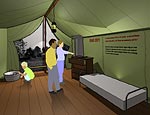New Project Award with the National Park Service - February 2006
The interactive exhibits tell the story of the decades-long voting rights crusade in Alabama that climaxed in March 1965 as Civil Rights activists converged on Selma, Alabama. The final push to achieve a nationwide solution to the disenfranchisement of African Americans came as the result of three strategically planned marches, the first of which took place on March 7. Nearly 500 marchers proceeded through the streets of Selma and across the Edmund Pettus Bridge where they were faced by scores of Alabama State troopers. The troopers attacked the non-violent marchers, leaving many of them bloodied and severely injured, on a date forever ensconced in history as “Bloody Sunday”.
A second march ended in a prayer session at the point of Sunday's confrontation. When an injunction circumventing the march to the Alabama State Capitol was reversed, a plan was devised to conduct the monumental trek on Sunday, March 21, 1965. Thousands of people, representing many races and nationalities, moved before the eyes of the world in demonstration to guarantee the right to vote. The five-day/four-night event covered a 54-mile route along state Highway 80 through chilling weather and rain. The result was the personal triumph of those who participated in the historic trek and the signing of the Voting Rights Act on August 6, 1965. Today, the Selma to Montgomery National Historic Trail stands as a testament to the sacrifices made in the triumph to preserve the “right to vote” as the bedrock of American democracy. The exhibits will be installed in February 2006 at the Tent City Interpretive Center in Whitehall, Alabama.

